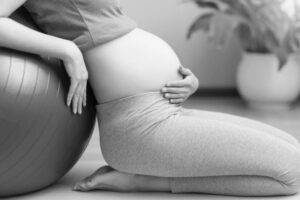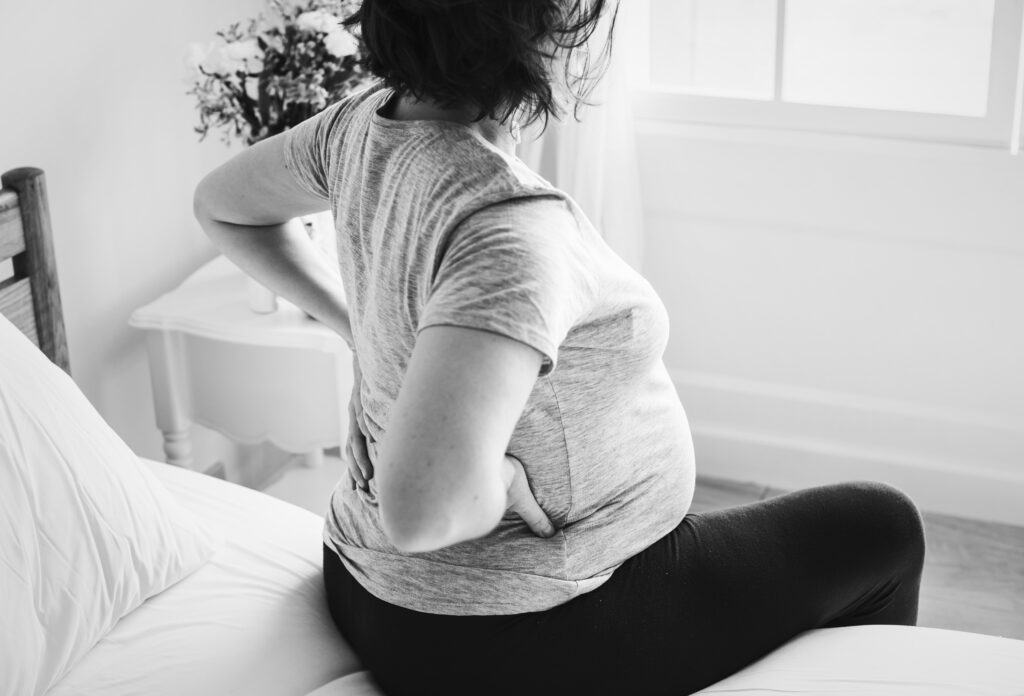The following is an overview of the most common complaints during pregnancy and recommendations to relieve discomfort. Regular pregnancy exercise (stretching and strength training), in addition to a daily walk, a conscious diet and rest, helps the most. Choose a workout you like, such as yoga for pregnant women, aqua aerobics or another group workout where you feel that you will get energy and also emotional support. Additional helpers are, for example, massage, kinesio taping and wearing a bandage. The Mamaco bandage comes with a pregnancy exercise plan. The plan includes simple exercises aimed at problem areas of the pregnant woman. It is suitable to do the exercises daily and to continue even after childbirth.
1. Pain in the pelvic region
Most pregnant women experience physical discomfort and pain in the pelvic region at some point, some have severe, constant and daily disturbing pain. Many pregnant women feel stronger pain in the area of the lower back, sacrum and pubic bone/symphysis, the pain can disturb sleep. Pelvic pain during pregnancy generally goes away after delivery. If the postpartum pain does not subside within a few months, it is recommended to consult a physiotherapist and start body strengthening exercises.
Complaints during pregnancy:
- pain in front of the pubic bone in the middle, about the height of the hips
- pain in the lower back, buttock on one or both sides and/or radiating to the leg
- pain in the area between the vagina and the anus (perineum)
- some women may feel or hear a clicking or snapping sensation in the hip and pelvic area
To alleviate complaints:
- avoid one position for a long time, e.g. sitting and standing for a long time
- pay attention to your positions and posture when standing and sitting, when resting, support yourself with pillows to increase comfort
- when moving up stairs, it can be helpful to step sideways
- if possible, avoid lifting heavy things while holding your breath, e.g. shopping bags or other children in the family, when lifting, move to a squatting position and exhale at the moment of lifting
2. Lower back pain
Lower back pain occurs most often during pregnancy and is possible in all trimesters. The pain can occur for the first time, but it can also be present earlier and worsen as the pregnancy progresses. During pregnancy, your body's otherwise stiff pelvic joints become softer and stretchier to prepare your body for childbirth. The added body weight and the weight of the stomach put pressure on the pelvic area, which gives a sensation of pain or radiation to the legs.
To prevent and relieve pain:
- to take/lift something from the floor, bend your knees and exhale when lifting
- avoid lifting heavy objects if possible; when carrying shopping bags, for example, try to balance the weight between the two bags
- wear comfortable and low shoes,
so that the body weight is evenly distributed on the lower body - support your back against the chair when sitting
- get enough rest and listen to your body and notice activities/positions that relieve or cause pain - choose appropriate activities and positions
- most massage or take a warm bath
- when sleeping, use a mattress where you feel like you are resting
3. Wrist pain during pregnancy
Pain is the most common complaint during pregnancy, occurring mostly in the lower back, less often in the shoulder girdle and wrist joints. Carpal tunnel syndrome is the main cause of upper extremity and wrist pain and its incidence varies from 1% - 25%. Carpal tunnel syndrome during pregnancy is thought to result from increased fluid retention,
which is caused by the interaction of several factors. Symptoms usually appear in the second or third trimester of pregnancy. A typical complaint is pain that increases during daily activities or especially at night, also numbness, "tingles" or "dying" of the hands. The pain can be alleviated by regular exercise.
Urinaryincontinence
 Rurinary incontinence is a common problem. In a survey of 1,900 women conducted by Netmums , showed that one in three women (34 percent) developed urinary incontinence during pregnancy, and the same number veis that the problem continued a year after the birth of the child. Rushing to the toilet or leaking while coughing, laughing, or exercising is often the result of overworked pelvic floor muscles. Hormones released during pregnancy affect the meats, empoweringthe baby stretch as it grows, this in turn makes the pelvic floor muscles "softer", which facilitates childbirth, but also promotes leakage. After childbirth, leaks can continue because childbirth traumatizes the pelvic floor muscles and their daily functioning (to ensure leakage). Many women with pregnancy-related incontinence find that pelvic floor muscle training (including Kegel exercises) significantly relieves the condition.
Rurinary incontinence is a common problem. In a survey of 1,900 women conducted by Netmums , showed that one in three women (34 percent) developed urinary incontinence during pregnancy, and the same number veis that the problem continued a year after the birth of the child. Rushing to the toilet or leaking while coughing, laughing, or exercising is often the result of overworked pelvic floor muscles. Hormones released during pregnancy affect the meats, empoweringthe baby stretch as it grows, this in turn makes the pelvic floor muscles "softer", which facilitates childbirth, but also promotes leakage. After childbirth, leaks can continue because childbirth traumatizes the pelvic floor muscles and their daily functioning (to ensure leakage). Many women with pregnancy-related incontinence find that pelvic floor muscle training (including Kegel exercises) significantly relieves the condition.
5. Constipation
Approximately 16-39% of women develop abdominal cramps during pregnancywhistle, mains reasons are considered to be:
- pregnancy hormones (progesterone) slow down the movement of stool through the intestines
- the physical size of the uterus slows the passage of stool through the intestine
- reduced physical activity
- diet (unhealthy choices, drinking less water)
- administration of iron supplements
Constipation can cause pain in the abdominal area, bloating and sharp attacks of abdominal pain. In addition to daily discomfort, long-term constipation increases the risk of pelvic floor problems, including:
- hemorrhoids
- intensification of prolapse complaints (heaviness/pain in the vaginal area)
- incontinence (bladder or bowel related)
Active physical activity, a fiber-rich diet and the consumption of plenty of liquids are important for supporting bowel function.
6. Swelling of the legs
Fluid retention, or swelling, is due to an increase in the amount of fluid during pregnancy. During the day, fluid in the body tends to accumulate in the lowest parts of the body, especially in warm weather or standing a lot. The pressure of the growing uterus can also affect the blood flow to the legs (including the appearance of varicose veins) and thereby promote the accumulation of fluid in the legs and feet.
To reduce swelling:
- avoid standing for long periods of time
- wear comfortable shoes and socks - avoid tight straps or anything that can squeeze your feet when they are swollen
- rest your feet higher than your body, e.g. when lying down, place pillows under your feet (including heels).
- drink enough water - it helps the body to reduce swelling
- exercise - regular walks, plus leg exercises or gymnastics for pregnant women
Sources
The summaries are based on the following public sources and research:
https://www.pelvicexercises.com.au/
https://dspace.ut.ee/server/api/core/bitstreams/374401a4-8e7b-4488-8a42-4131e68ec905/content


